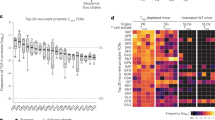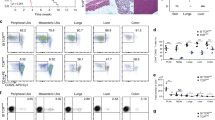Abstract
CLONAL deletion plays a major part in the maintenance of natural self-tolerance in both normal1–5 and transgenic6–9 mice. Self antigens that are expressed in the thymus result in the physical elimination of autoreactive thymocytes at a particular stage in their development. For example, the majority Vβ6- and Vβ8.1-bearing T cells that recognize the minor lymphocyte-stimulating antigen, Mis-1a (ref. 10), are clonally deleted in the thymuses of normal mice and transgenic mice expressing Mis-1a (refs 2, 3, 9). In contrast, a very different mechanism of tolerance involving the functional inactivation, but not elimination, of autoreactive cells, termed clonal inactivation or clonal anergy, has been implicated in some experimentally manipulated systems of tolerance11–15. To test further the mechanisms involved in self-tolerance, we have generated transgenic mice expressing a Vβ 8.1 beta chain on >95% of peripheral T cells and have tested tolerance to Mis-1a in these mice. Surprisingly, a significant fraction of the CD4+ peripheral cells that survived deletion were non-responsive in vitro to any stimulus tested. Naturally occurring tolerance to a self antigen expressed in the thymus can thus be mediated by clonal anergy, as well as by clonal deletion.
This is a preview of subscription content, access via your institution
Access options
Subscribe to this journal
Receive 51 print issues and online access
$199.00 per year
only $3.90 per issue
Buy this article
- Purchase on Springer Link
- Instant access to full article PDF
Prices may be subject to local taxes which are calculated during checkout
Similar content being viewed by others
References
Kappler, J., Roehm, N. & Marrack, P. Cell 49, 273–280 (1987).
Kappler, J., Staerz, U., White, J. & Marrack, P. Nature 332, 35–40 (1988).
MacDonald, H. R. et al. Nature 332, 40–45 (1988).
Pullen, A. M., Marrack, P. & Kappler, J. W. Nature 335, 796–801 (1988).
Bill, J., Kanagawa, O., Woodland, D. & Palmer, E. J. exp. Med. 169, 1405–1419 (1989).
Kisielow, P., Bluthmann, H., Staerz, U. D., Steinmetz, M. & vonBoehmer, H. Nature 333, 742–746 (1988).
Sha, W. C. et al. Nature 336, 73–76 (1988).
Berg, L., Fazekas de St. Groth, B., Pullen, A. & Davis, M. Nature 340, 559–562 (1989).
Pircher, H. et al. EMB0 J. 8, 719–727 (1989).
Festenstein, H. Trans. Rev. 15, 62–88 (1973).
Lo, D. et al. Cell 53, 159–168 (1988).
Lo, D., Burkly, L., Flavell, R., Palmiter, R. & Brinster, R. J. exp. Med. 170, 87–104 (1989).
Qin, S., Cobbold, S., Benjamin, R. & Waldmann, H. J. exp. Med. 169, 779–794 (1989).
Rammensee, H.-G., Kroschewski, R. & Frangoulis, B. Nature 339, 541–544 (1989).
Ramsdell, F., Lantz, T. & Fowlkes, B. J. Science 246, 1038–1041 (1989).
Marrack, P. & Kappler, J. Science 238, 1073–1079 (1987).
Kappler, J. et al. Cell 49, 263–271 (1987).
White, J. et al. Cell 56, 27–35 (1989).
Happ, M. P., Woodland, D. L. & Palmer, E. Proc. natn. Acad. Sci. U.S.A. 86, 6293–6296 (1989).
MacDonald, H. R. et al. J. exp. Med. 167, 2005–2010 (1988).
Krimpenfort, P. et al. EMBO J. 7, 745–750 (1988).
Blackman, A. A. et al. Cell 47, 349–357 (1986).
Haskins, K. et al. J. exp. Med. 160, 452–471 (1984).
Janeway, C. A. Jr et al. Immunol. Rev. 15, 62–88 (1989).
Kubo, R., Born, W., Kappler, J., Marrack, P. & Pigeon, M. J. Immun. 142, 2736–2742 (1989).
Leo, O., Foo, M., Sachs, D. H., Samelson, L. S. & Bluestone, J. A. Proc. natn. Acad. Sci. U.S.A. 83, 767–771 (1987).
Fowlkes, B. J., Schwartz, R. H. & Pardoll, D. M. Nature 334, 620–623 (1988).
Goodnow, C. C. et al. Nature 334, 676–682 (1988).
Finkel, T. H. et al. Cell 58, 1047–1054 (1989).
Staerz, U., Rammensee, H., Benedetto, J. & Bevan, M. J. Immun. 134, 3994–4000 (1985).
Mosmann, T. J. Immun. Meth. 65, 55–63 (1983).
Author information
Authors and Affiliations
Rights and permissions
About this article
Cite this article
Blackman, M., Gerhard-Burgert, H., Woodland, D. et al. A role for clonal inactivation in T cell tolerance to Mis-1a. Nature 345, 540–542 (1990). https://doi.org/10.1038/345540a0
Received:
Accepted:
Issue Date:
DOI: https://doi.org/10.1038/345540a0
This article is cited by
-
Prevalent de novo somatic mutations in superantigen genes of mouse mammary tumor viruses in the genome of C57BL/6J mice and its potential implication in the immune system
BMC Immunology (2011)
-
Erratum: A role for clonal inactivation in T cell tolerance to Mls-1a
Nature (2008)
-
Regulatory mechanisms of the immune system in multiple sclerosis. T regulatory cells: turned on to turn off
Journal of Neurology (2007)
-
Biochemical features of anergic T cells
Immunologic Research (1998)
-
Role of the T cell receptor α-chain in superantigen recognition
Immunologic Research (1996)
Comments
By submitting a comment you agree to abide by our Terms and Community Guidelines. If you find something abusive or that does not comply with our terms or guidelines please flag it as inappropriate.



